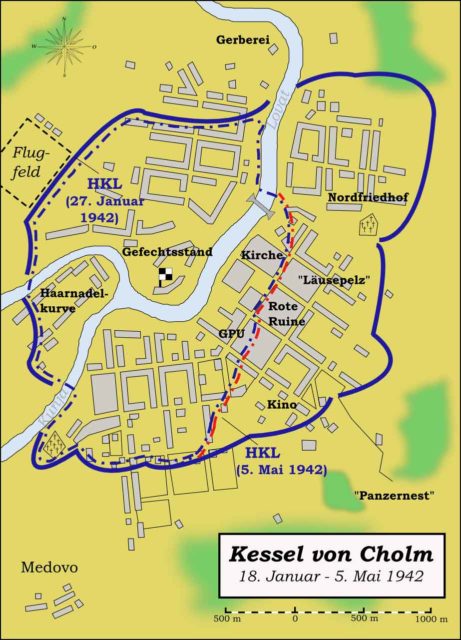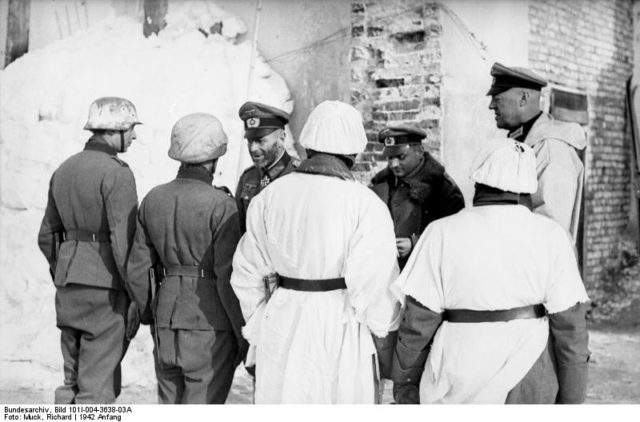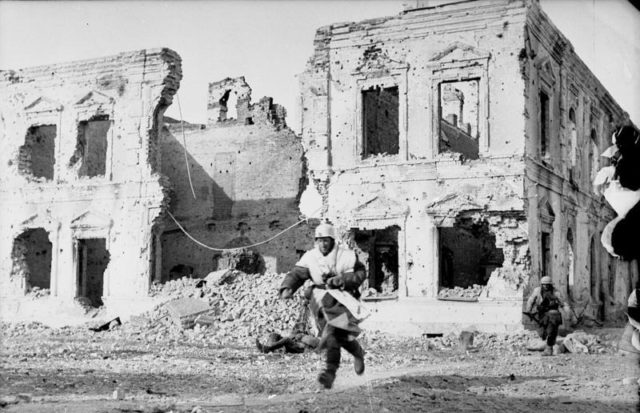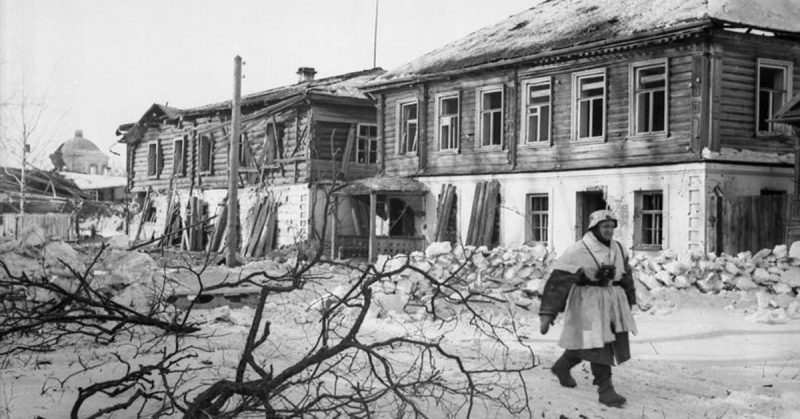War History online proudly presents this Guest Piece from Evan Pinter
In history, there have been many great examples of heroic last stands. Among the most famous include the last of the Samurai at Shiroyama, the Spartans at Thermopylae, or the British at Rorke’s Drift. But, as is the nature of historiography, there remain many others that were no less outstanding and yet have been largely forgotten. And WWII had many of these. One of the most impressive of all was the 105-day siege of Kholm.
Kholm is one of many small Russian towns, with a prewar population of around 10,000 people. In the winter of 1941-42, however, it attained major strategic significance. The Russians had encircled a major portion of the German 16th Army and needed to capture the town if they continued to follow up their successes against the Germans in this sector. Because of this Hitler (as was usually the case) ordered it to be held to the last man, and in January 1942 the Germans rallied what forces they had in the area to the town under the overall command of Major General Theodor Scherer. They would be known as Kampfgruppe (battle group) Scherer.
The Germans faced many difficulties as they prepared the town for defense. For starters the defenders were no elite band, they were a hodgepodge of security forces, construction troops, Luftwaffe personnel, police and even drivers from the Navy, in addition to regular infantry. They totaled about 5,500 men. They were heavily short of artillery and anti-tank weapons, indeed when the fighting began not a single anti-tank gun could be found! Finally, the freezing weather made both fighting and resupply difficult, and more than anything there would be no hope of an early relief. And all too soon, on January 27th, the Russians completed their encirclement of the town.

On the other hand, Kholm was well-built for defense, being set on a hill with good views over the surrounding marshland as well as having a number of well-built stone buildings. And though cut off, Scherer’s garrison would have intermittent artillery support from Group Uckermann, located 10 kilometers west of Kholm. With this in mind, Scherer prepared for the first Russian attacks.

They were mostly probes at first. The Russians too were having supply problems given the bad weather and infrastructure, initially attacking only with infantry with a handful of tanks. Nevertheless, they gave Scherer’s pressed garrison a hard time and even captured the town’s airfield, critical for the resupply of the garrison. Scherer’s men retook it after hard fighting. Both sides took heavy losses, but eventually, the Germans were able to dig in tightly on a perimeter that was about 2km wide. The Germans had been able to hold out in large part because the attackers were too weak at first. This would soon change.
The Russians were reinforced with a fresh rifle division, tank battalion and artillery regiment, resulting in a strength of 23,000 Russians against 4,500 Germans. The Russians were quick to press their advantage and launched a combined arms assault that pushed through as far as Scherer’s HQ, where Scherer himself was slightly wounded. However, despite high losses and ammunition expenditure, the Germans held on, knocking out Russian tanks with Teller mines, grenades or whatever other weapons could be found.
At this point, the Russians had rendered the airfield unusable, with the only option for supplying the garrison being gliders and later airdrops to fulfill their requirements of 15 tons of food and ammunition per day. Needless to say, the Germans were getting only barely enough this way. And worse was to come. The Russians had been reinforced with a full rifle corps and began their next big assault on 21 February.
Scherer and his men faced multiple heavy attacks from more than one direction, and yet somehow held the line. They were aided by the fact that Kholm’s streets were narrow, giving the Soviet infantry no room to maneuver. Such conditions led to great slaughter among the attackers. There were even times when the attacking waves were so dense that dead men in the first line were unable to fall down through the mass of bodies behind them and were carried along in the attack. In a span of just over 2 days, the fighting carried on, with 18 major attacks of which many were tank-supported. However, despite being pressed into a space of only 200 x 500m, Kampfgruppe Scherer did not yield the town.

By the end of March over half the garrison was either wounded or seriously ill, with a Typhus outbreak making life no easier for the soldiers in such a packed space. There were only 300g of bread available for each man daily. Even wounded soldiers were put into the line to keep it up to strength. But time and time again Russian attacks were repulsed. Even after the snow had melted in April the Germans held on throughout the month.
As the defenders of Kholm fought for their lives, the German forces on the outside had tried to relieve the defenders on multiple occasions. All attempts through winter had failed, but now, reinforced, the Germans attempted once again to relieve the garrison at the end of April. The Russians decided to destroy the garrison once and for all before help could arrive. On May 1st the Russians launched a huge bombardment followed by a division-sized attack with 15 tanks in support. Once again, despite many moments of crisis the Germans held on, and nine Russian tanks were destroyed.
Finally, on 5 May, contact was restored between Scherer’s beleaguered Kampfgruppe and the German relief force. In total this ragtag of troops had repelled 100 major Soviet attacks as well as destroying 2 aircraft and 42 tanks in their 105-day long fight for survival. The Russians had lost 20-25,000 men in the battle of Kholm. The defenders’ own losses were also high, having suffered 1,550 dead and 2,200 wounded by the time the battle ended. Only 1,200 were still fit for action when the relief force arrived. However, they had achieved a major defensive success, despite being cut off from friendly forces for a grand total of 105 days. Their efforts were recognized by the creation and reception of a campaign medal, the Kholm shield. It was one of only five such campaign medals instituted and the rarest of the lot. Theodor Scherer was awarded the Knight’s Cross with Oakleaves for his skillful leadership during the siege, a siege which must surely count as one of the great stands of history.
Author: Evan Pinter
